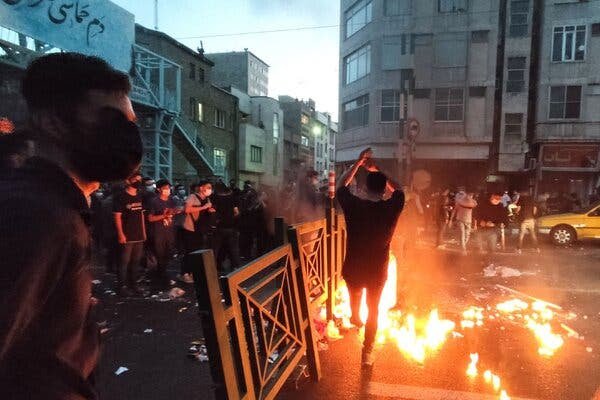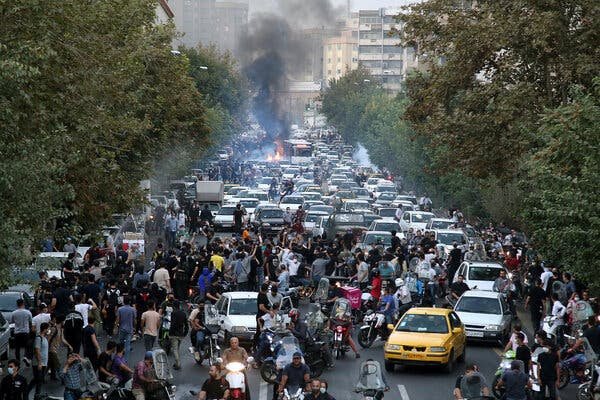‘They Have Nothing to Lose’: Why Young Iranians Are Rising Up Once Again
Amid growing repression, a sickly economy and bleak prospects, the death of one young woman was all it took.
Demonstrators on the streets of Tehran this past week. Protests spurred by a woman’s death in custody have expanded to include outrage over economic problems and frustration with moral strictures.Credit...Agence France-Presse — Getty Images
By Vivian Yee and Farnaz Fassihi
Published Sept. 24, 2022Updated Sept. 26, 2022
The 22-year-old woman emerged from the Tehran subway, her dark hair covered with a black head scarf and the lines of her body obscured by loose clothing, when the capital city’s Guidance Patrol spotted her. They were members of Iran’s notorious morality police, enforcers of the conservative Islamic dress and behavior rules that have governed daily life for Iranians since the 1979 revolution, and newly energized under a hard-line president who took office last year.
By their standards, Mahsa Amini was improperly dressed, which could mean something as simple as a wisp of hair protruding from her head scarf. They put her in a van and drove her away to a detention center, where she was to undergo re-education. Three days later, on Sept. 16, she was dead.
Now, over eight days of rage, exhilaration and street battles, the most significant outpouring of anger with the ruling system in more than a decade, her name is everywhere. Iranian protesters in dozens of cities have chanted “women, life and freedom” and “death to the dictator,” rejecting the Iranian Republic’s theocratic rule by targeting one of its most fundamental and divisive symbols — the ailing supreme leader, Ayatollah Ali Khamenei.
In several of the videos of the uprising that have torn across social media, women rip off their head scarves and burn them in street bonfires, including in deeply religious cities such as Qum and Mashhad. In one, a young woman atop a utility cabinet cuts off her hair in front of a crowd of roaring demonstrators. In another, young women dare to dance bareheaded in front of the riot police.
“Death to the dictator,” protesters at Tehran University chanted on Saturday. “Death to the head scarf! Until when must we tolerate such humiliation?”
Protesters in the streets of Tehran on Wednesday.Credit...Associated Press
Previous protests — over fraudulent elections in 2009, economic mismanagement in 2017 and fuel price hikes in 2019 — have been ruthlessly suppressed by Iran’s security forces, and this time may be no different. Yet, for the first time since the founding of the Iranian Republic, the current uprising has united rich Iranians descending from high-rise apartments in northern Tehran with struggling bazaar vendors in its working-class south, and Kurds, Turks and other ethnic minorities with members of the Fars majority.
The sheer diversity of the protesters reflects the breadth of Iranians’ grievances, analysts say, from a sickly economy and in-your-face corruption, to political repression and social restrictions — frustrations Iran’s government has repeatedly tried, and failed, to quash.
“The anger isn’t over just Mahsa’s death, but that she should have never been arrested in the first place,” said Shadi Sadr, a prominent human rights lawyer who has campaigned for Iranian women’s rights for two decades.
“Because they have nothing to lose,” she added, “they are standing up and saying, ‘Enough of this. I am willing to die to have a life worth living.’”
Information about the protests remains partial at best. Internet access continues to be disrupted or fully blocked, especially on widely used messaging apps such as WhatsApp and Instagram, making it difficult for Iranians to communicate with one another or to share updates on the unrest with the outside world.
But witnesses say the demonstrations, which spread to at least 80 cities on Saturday, are the most forceful, vitriolic and emboldened they can remember, far more intense than the previous tremors of unrest. Desperate to damage the powers-that-be before the inevitable crackdown, videos circulating on social media and shared with The New York Times show, protesters have set fire to security vehicles and assaulted members of Iran’s widely feared paramilitary forces, in some cases killing them.



